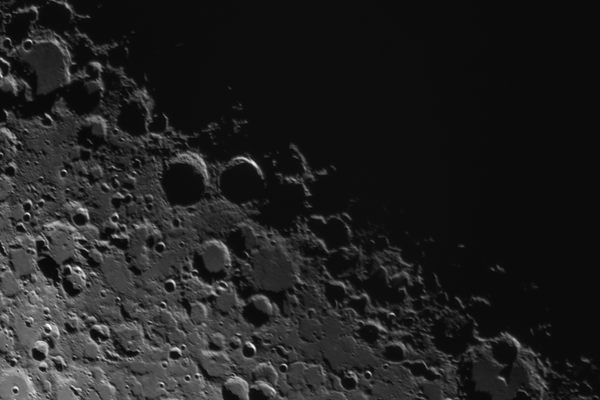Is It a Super Blue Moon or a Blue Supermoon?
Whatever you call it, this week’s full moon is particularly rare—we won’t see one again until 2037.
Atlas Obscura’s Wondersky columnist Rebecca Boyle is an award-winning science journalist and author of the upcoming Our Moon: How Earth’s Celestial Companion Transformed the Planet, Guided Evolution, and Made Us Who We Are (January 2024, Random House). She shares the stories and secrets of our wondrous night sky.
The celestial event that brings summer to a close is one you might typically take for granted. It’s a full Moon again, when Earth’s companion is opposite the sun from us, and its whole face is illuminated in our sky. A full Moon happens every month, of course. But that reliable return belies the distinctive, individual nature of each lunar cycle. And this full Moon has more superlatives than most.
The full Moon comes back every month—that’s why it’s called a month—but pay close attention, and you will notice that each of them is very different from one another. There are summer full Moons, sailing low in the sky and often hazy from humidity in the lower atmosphere; harvest Moons that beam ghostly pale light through freshly bare trees; high winter Moons, illuminating new-fallen snow. There are supermoons, micromoons, blood Moons, blue Moons.
This full Moon peaks overnight on Aug. 30 into Aug. 31, but it will look full from Tuesday through Friday of this week. It is a full, super, blue Moon, the only blue Moon of 2023, and a lunar trifecta that won’t occur again until 2037.
Many cultures around Earth imbue certain lunar cycles with meaning, using full or crescent Moons to mark celebrations or festivals. The Aug. 30-31 full Moon, for instance, marks a Hindu festival called Raksha Bandhan, also known as Rakhi Purnima, which celebrates the bond between brothers and sisters. This full Moon also heralds preparation for the Jewish New Year: Rosh Hashanah begins on the night when this full Moon fades and a new Moon phase begins, on Sept. 15.
At sunset, look to the eastern-southeastern horizon, and you may be able to see the Moon rising. It will be near Saturn, which I hope you saw last week. You can use this tool to calculate the precise time when the Moon rises in your location. If you can see moonrise clearly, you might be surprised at how big the Moon appears to be, as it climbs above the sea, the city, or your backyard.

This Moon is indeed a supermoon—our satellite is again at its closest point to Earth during this orbit, so it will look up to 14 percent larger and brighter than usual—but the gargantuan Moon cresting Earth’s horizon is not as big as it looks. The so-called Moon illusion is a strange, not-well-understood phenomenon that makes the Moon look huge because of how it is arrayed against the landscape, or objects in the foreground. Although no one can yet fully explain this trick of our brains’ visual systems, you can prove the illusion to yourself: Hold up your index finger, point to the Moon, and notice that your fingernail is about the same size as the orb in the sky. The full Moon is super, but it is not gigantic.
It won’t actually be blue, either. The name “blue Moon” refers to the phenomenon of two full Moons in a calendar month. The Moon orbits Earth every 29.5 days, so most of the time, each month gets one full lunar cycle. But every couple years, a lunar cycle completes and restarts within the span of one calendar month, so that the full Moon appears twice. Aug. 1 saw a full Moon, and Aug. 30 will as well, so this one is a blue Moon. The last blue Moon occurred in August 2021, and the next one is in August 2024. These are relatively rare, hence the expression “once in a blue Moon.”
Depending on where you are, the Moon as it rises may be tinged with yellow or orange instead of blue. Earth’s atmosphere bends and scatters light from the sun, and blue light scatters more easily than other colors, so it usually dominates our sky, even though the sun actually emits all colors. (Check out this helpful explainer from NOAA for more details about why the sky is blue.) But when Earth’s atmosphere has extra particles in it from wildfire smoke or even humidity, more of the blue light is absorbed and redder light dominates. If you’re in an area under wildfire haze, the blue Moon may rise reddish.
Once it has fully risen, however, this blue Moon will look like its usual opalescent self. If you can, take note of its position in the sky. Does it seem higher than it did back in June? Is there a halo of light surrounding it, or is the high summer humidity starting to fade for you? Do you see Saturn near the Moon’s upper right? For that matter, can you find Vega, high overhead? Do you recognize any other summer sights?
I hope you feel newly connected to all these objects, and what they represent now and in the past. I hope next time there’s a full Moon, at the end of September, you take note again of how it looks different from prior months. The night sky always changes, but it will always be there for you, if you just go out and look.
Is there something you’d like to know about our brilliant night sky? Share your stargazing questions with us and you may see them answered in a future Wondersky column!










Follow us on Twitter to get the latest on the world's hidden wonders.
Like us on Facebook to get the latest on the world's hidden wonders.
Follow us on Twitter Like us on Facebook